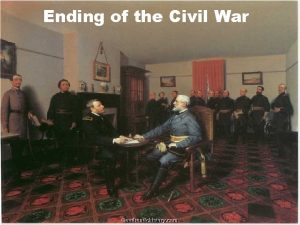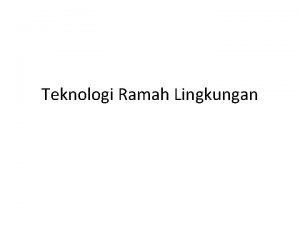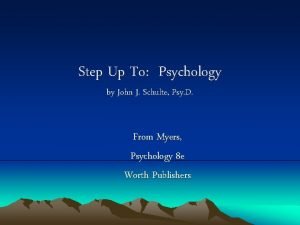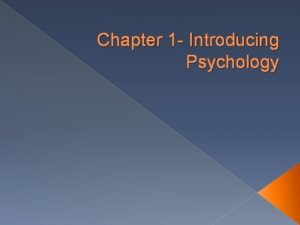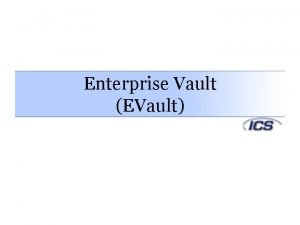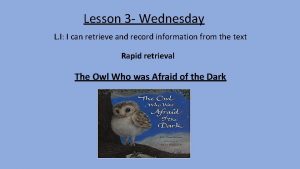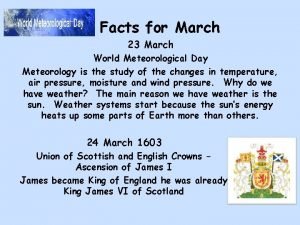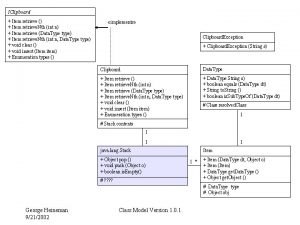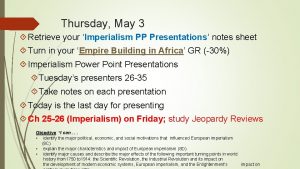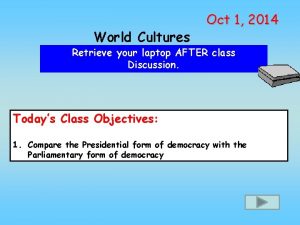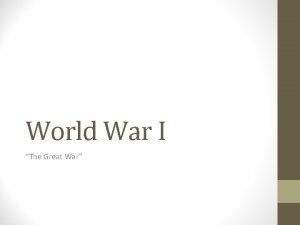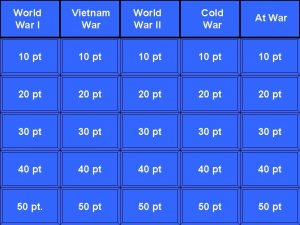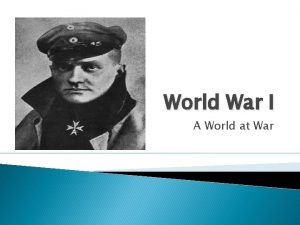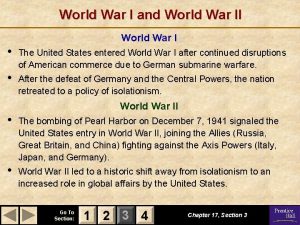Thursday March 29 Retrieve your World War I














- Slides: 14

Thursday, March 29 Retrieve your ‘World War I Power Point’ notes ‘World War I Power Point AP Mock Exam Instructions Ch 32 -33 Test on Monday, April 2 AP World History Mock Exam on Tuesday, April 3 Be in the library no later than 8: 15 am Objective: “I can. . . - identify the importance of imperialism, nationalism, militarism, and the alliance system in causing World War I (10 A) - explain the political impact of Woodrow Wilson’s Fourteen Points and the political and economic impact of the Treaty of Versailles, including changes in boundaries and the mandate system (10 C)

AP Mock Exam SECTION I – 1 hour and 35 minutes 1. Multiple Choice Questions 55 questions in 55 minutes Prompts followed by 3 -4 questions 2. Short Answer Questions (SAQ) 3 prompts with 3 questions each 9 short answers in 40 minutes 10 – minute break SECTION II – 1 hour and 40 minutes 1. Document Based Question Essay (DBQ) 6 paragraph essay in 60 minutes 2. Long Essay Question (LEQ) 6 paragraph essay in 40 minutes

Section 1 – Part A Multiple Choice Section I: Part A Multiple Choice — 55 Questions | 55 Minutes | 40% of Exam Score Questions appear in sets of 2 to 5. Students analyze historical texts, interpretations, and evidence. Primary and secondary sources, images, graphs, and maps are included.

MC Prompt – Quote or Passage

MC Prompt – Chart or Graphic

MC Prompt - Map

MC Prompt - Picture

Section 1 - Part B Short Answer Questions (SAQ) Short Answer — 3 Questions | 40 Minutes | 20% of Exam Score Analyze historians' interpretations, historical sources, and propositions about history. Questions provide opportunities for students to explain the historical examples that they know best. Some questions include texts, images, graphs, or maps. Update for 2017 -18: Students will choose between two options for the final required short-answer question, each one focusing on a different time period. Question 1 (required): periods 3 -6 Question 2 (required): periods 3 -6 Students choose between Question 3, periods 1 -3, and Question 4, periods 4 -6

SAQ – A. C. E.

Section II – Part A Document Based Question (DBQ) Document Based — 1 Question | 60 Minutes (includes 15 -minute reading period) | 25% of Exam Score Assess written, quantitative, or visual materials as historical evidence. Develop an argument supported by an analysis of historical evidence. Update for 2017 -18: This essay will focus on topics from periods 3 -6.

DBQ - Rubric • Thesis – (1 pt) • Contextualization – (1 pt) • Evidence – (3 pts) • Acceptable use of 3 documents (1 pt) • Acceptable use of 6 documents (1 pt) • Use of outside evidence not in documents (1 pt) • Analysis & Reasoning (2 pts) • POV, Purpose, Audience, Historical Context on at least 3 documents (1 pt) • Complex understanding (1 pt)

Section II – Part B Long Essay Question (LEQ) Long Essay — 1 Question | 40 Minutes | 15% of Exam Score Explain and analyze significant issues in world history. Develop an argument supported by an analysis of historical evidence. Updates for 2017 -18: The question choices will continue to focus on the same theme and skill but will now allow students to select among three options, each focusing on a different range of time periods: Option 1: periods 1 -2 Option 2: periods 3 -4 Option 3: periods 5 -6

LEQ Rubric • Thesis – (1 pt) • Contextualization – (1 pt) • Evidence – (2 pts) • Provide specific examples relevant to the prompt (1 pt) • Provide specific examples that support your argument (1 pt) • Analysis & Reasoning (2 pts) • Uses historical reasoning skills to structure argument (1 pt) • Demonstrates a complex understanding (1 pt)

LEQ Example Prompt Question 2: In the period before 600 b. c. e, the adoption of agriculture had significant social, economic, and demographic effects. Develop an argument that evaluates how the adoption of agriculture in this time period affected the development of human societies. Question 3: In the period circa 400– 1450 c. e. , the decline and reconstitution of empires in regions such as the Mediterranean, Middle-East, and East Asia, affected the expansion or decline of cities across Afro-Eurasia. Develop an argument that evaluates how the process of decline and reconstitution of empires led to changes in urban development in Afro-Eurasia in the period circa 400– 1450 c. e. . Question 4: In the period 1950 to 2001, scientific and technological innovations led to advances in communication, transportation, and industry that transformed the world’s economy. Develop an argument that evaluates how globalization transformed the world’s economy during this time period.
 Anthem of poland
Anthem of poland Civil war map sherman's march to the sea
Civil war map sherman's march to the sea Pengertian dan prinsip teknologi ramah lingkungan
Pengertian dan prinsip teknologi ramah lingkungan Five year old tammy mistakenly believes that her short
Five year old tammy mistakenly believes that her short Reading vipers retrieve
Reading vipers retrieve Key events in a story
Key events in a story How we encode process store and retrieve information
How we encode process store and retrieve information How to enable enterprise vault in outlook
How to enable enterprise vault in outlook Retrieve
Retrieve March 23 world meteorological day
March 23 world meteorological day Give us your hungry your tired your poor
Give us your hungry your tired your poor James madison war at home
James madison war at home Description
Description The cold war lesson 1 the cold war begins
The cold war lesson 1 the cold war begins Sclc and sncc venn diagram
Sclc and sncc venn diagram

